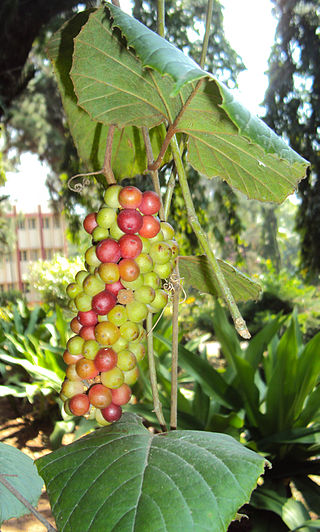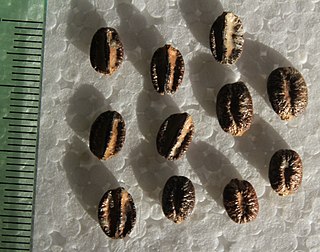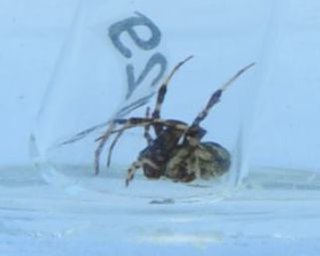
The Vitaceae are a family of flowering plants, with 14 genera and around 910 known species, including common plants such as grapevines and Virginia creeper. The family name is derived from the genus Vitis.

Gulf Province is a province of Papua New Guinea located on the southern coast. The provincial capital is Kerema. The 34,472 km2 province is dominated by mountains, lowland river deltas, and grassland flood plains. In Gulf Province, the Kikori, Turama, Purari, and Vailala rivers meet the Papuan Gulf. The province has the second-smallest population of all the provinces of Papua New Guinea with 106,898 inhabitants. The province shares land borders with Western Province to the west, Southern Highlands, Chimbu, and Eastern Highlands to the north, Morobe Province to the east, and Central Province to the southeast.

Morobe Province is a province on the northern coast of Papua New Guinea. The provincial capital and largest city is Lae. The province covers 33,705 km2, with a population of 674,810, and since the division of Southern Highlands Province in May 2012 it is the most populous province. It includes the Huon Peninsula, the Markham River, and delta, and coastal territories along the Huon Gulf. The province has nine administrative districts. At least 101 languages are spoken, including Kâte and Yabem language. English and Tok Pisin are common languages in the urban areas, and in some areas pidgin forms of German are mixed with the native language.

The eastern long-beaked echidna, also known as Barton's long-beaked echidna, is one of three species from the genus Zaglossus to occur in New Guinea. It is found mainly in the eastern half at elevations between 2,000 and 3,000 metres.

Romnalda is a genus of monocotyledonous plants in the family Asparagaceae, subfamily Lomandroideae. As of December 2013 four formally named species are known and accepted by botanical science.

Papua New Guinea together with the West Papua region of Indonesia make up a major tropical wilderness area that still contains 5% of the original and untouched tropical high-biodiversity terrestrial ecosystems. PNG in itself contains over 5% of the world's biodiversity in less than 1% of the world's total land area. The flora of New Guinea is unique because it has two sources of origin; the Gondwana flora from the south and flora with Asian origin from the west. As a result, New Guinea shares major family and genera with Australia and the East Asia, but is rich in local endemic species. The endemicity is a result of mountainous isolation, topographic and soil habitat heterogeneity, high forest disturbance rates and abundant aseasonal rainfall year round. PNG boasts some 15–21,000 higher plants, 3,000 species of orchids, 800 species of coral, 600 species of fish, 250 species of mammals and 760 species of birds and 8 species of tree-kangaroos out of which 84 genera of animals are endemic. Ecosystems range from lowland forests to montane forests, alpine flora down to coastal areas which contains some of the most extensive pristine mangrove areas in the world. Much of this biodiversity has remained intact for thousands of years because the ruggedness of the terrain made the interior lands inaccessible; furthermore low population density and restrictions on the effectiveness of traditional tools, ensured that these biodiversity was never overexploited.
The angulate pipistrelle, also known as the New Guinea pipistrelle, is a species of vesper bat found in Papua New Guinea and the Solomon Islands.
Nyctimystes trachydermis, also known as the Morobe big-eyed treefrog, is a species of frog in the subfamily Pelodryadinae of the family Hylidae. It is endemic to Papua New Guinea and occurs in the mountains of southern eastern New Guinea. Its type locality is Gapaia Creek, at 1,280 m (4,200 ft) asl between Garaina and Saureli, in the Morobe Province. The specific name trachydermis means "rough skinned", derived from the Greek words trachys and derma.
Nyctimystes tyleri is a species of frog in the subfamily Pelodryadinae of the family Hylidae. It is endemic to Papua New Guinea and only known from its type locality, Gapaia Creek, between Garaina and Saureli, in the Morobe Province. The specific name honours Michael J. Tyler, an Australian herpetologist, "in recognition of his notable contributions to the systematics of Australo-papuan frogs." Common name Tyler's big-eyed treefrog has been coined for this species.

The black-spotted cuscus is a species of marsupial in the family Phalangeridae. It is among the largest members of the family, only being surpassed by the bear cuscus. It is a relatively colourful species found in forests of northern New Guinea. It is threatened by hunting and habitat loss, and has already disappeared from large parts of its range. Consequently, it is rated as Critically Endangered by IUCN.

Heterospathe is a monoecious genus of flowering plant in the palm family found in Oceania, where it is called sagisi palm. With 39 species, Heterospathe is named from a Greek combination of "various" and "spathe", which describes the two distinct bract types.

New Guinea is the world's second-largest island, with an area of 785,753 km2 (303,381 sq mi). Located in Melanesia in the southwestern Pacific Ocean, the island is separated from Australia by the 150-kilometre wide Torres Strait, though both landmasses lie on the same continental shelf. Numerous smaller islands are located to the west and east. The island's name was given by Spanish explorer Yñigo Ortiz de Retez during his maritime expedition of 1545 due to the resemblance of the indigenous peoples of the island to those in the African region of Guinea.

Ampelocissus is a genus of Vitaceae having 90 or more species found variously in tropical Africa, Asia, Central America, and Oceania. The type species, A. latifolia, was originally treated under its basionym, Vitis latifolia, and was collected from the Indian subcontinent.
Ampelocissus africana is a type of vine that is woody, or liana of the grape family, bearing edible fruit. It is native to habitats in, and around forested areas in Guinea, Ivory Coast, Nigeria, Cameroon, Chad, Central African Republic, Sudan, Kenya, Rwanda, Burundi, Tanzania, Malawi, Zambia, Mozambique, Zimbabwe and Botswana. It was originally described botanically in 1790 by João de Loureiro as Botria africanus, which is the basionym for its treatment here under Ampelocissus.

Mount Shungol is an ultra-prominent summit to the west of Lae, in Morobe Province, Papua New Guinea. It is in the Herzog Mountain Range and has an elevation of 2,752 metres (9,029 ft). The Buang people claim ownership to the top of Mount Shungol.

Yalu is a large village in Wampar Rural LLG, located in the Markham Valley of Morobe Province, Papua New Guinea. It lies along the Highlands Highway 21.5 kilometres (13.4 mi) north-west of Lae, 7 kilometres (4.3 mi) southeast of Nadzab. The landscape is typically lowland rainforest.

Philippe Cuénoud is a Swiss entomologist and botanist living in Onex, who worked on the Psocoptera of Switzerland and Papua New Guinea, as well as on plant phylogeny. He found the only recently known population of Lachesilla rossica near Geneva and contributed further to the knowledge of the flora and fauna of the canton of Geneva with the first mention of a slender-billed gull and with the discovery of the first reported population of small-leaved helleborines. He also participated in a multidisciplinary study of the free-living fauna and flora of Basel's Zoo. In a 1999 trip to Brasil with Alain Chautems, he was among the first few people to see the newly rediscovered flower Sinningia araneosa, that had gone missing for more than a century.

Ampelocissus martini is a species of climber or shrub in the Vitaceae family. Some sources use the spelling Ampelocissus martinii. It is native to an area of Mainland Southeast Asia. The fruit are eaten by people and by several species of Pangasiidae shark catfish of the Mekong river.

Gea eff is a species of orb-weaver spider. It is found in Papua New Guinea. The arachnologist Herbert Walter Levi formally described the species in 1983. While it was still undescribed, Michael H. Robinson and colleagues reported on its courtship and mating behaviors. Gea eff has the shortest scientific name of any spider species.
















